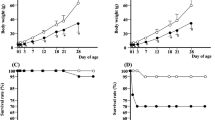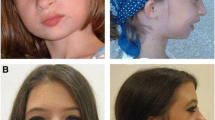Abstract
The little (lit) autosomal recessive mutation in the mouse causes dwarfism due to isolated growth hormone deficiency. The in vitro physiology of pituitary growth hormone release in lit/lit animals suggests that an abnormality in the growth hormone releasing factor (GRF) receptor (Ghrfr) is a very likely candidate for the lit mutation. We mapped Ghrfr to the region around lit on Chromosome (Chr) 6 in 100 chromosomes of an FVB x Czech II interspecific backcross. Molecular markers were Neuropeptide Y (Npy), homeobox (Hoxa2), immunoglobulin kappa chain (Igk), wingless-related MMTV integration site (Wnt-2), cystic fibrosis (Cftr), carboxypeptidase A (Cpa), and Ghrfr. Map order and distances were as follows: Cen-//-Wnt-2-(0 cM)-Cftr-(6.0 cM)-Cpa-(8.0 cM)-Npy-(1.0 cM)-Hoxa2-(3.0 cM)-Ghrfr-(2.0 cM)-Igk. We mapped lit (by phenotype) relative to Hoxa2 and Igk on 72 F2 chromosomes of offspring of a B6CZ lit/ + x B6FVB lit/ + intercross and 18 chromosomes of offspring of a B6FVB lit/ + intercross. Map order and distances were as follows: Hoxa2-(2.1 cM)-lit/Ghrfr-(3.7 cM)-Igk. No recombinations between lit and Ghrfr were detected. Thus, Ghrfr maps to mouse Chr 6 and may be allelic with lit. Amplification of a short segment at the 3′ end of the Ghrfr mRNA by reverse transcription coupled to the polymerase chain reaction showed a greatly diminished level of GRF receptor mRNA in the pituitaries of lit/lit mice as compared with lit/ + controls. Low level of message could reflect a primary molecular defect or be due to secondary hypoplasia of somatotropes. These genetic and molecular data suggest that the Ghrfr gene is mutated in the lit mouse.
Similar content being viewed by others
References
Abrahams, D.M., Rizzardi, F. (1988). BLSS The Berkeley Interactive Statistical System. New York: W.W. Norton & Company, Inc.
Acampora, D., D'Esposito, M., Faiella, A., Pannese, M. Migiaccio, E., Morelli, F., Stomaiulo, A., Nigro, V., Simeone, A., Boncinelli, E. (1989). The human HOX gene family. Nucleic Acids Res. 17, 10385.
Bahary, N., Zorich, G., Pachter, J.E., Leibel, R.L., Friedman, J.M. (1991). Molecular genetic linkage maps to mouse chromosomes 4 and 6. Genomics 11, 33–47.
Beamer, W.G., Eicher, E.M. (1976). Stimulation of growth in the little mouse. J. Endocrinol. 71, 37–45.
Billestrup, N., Swanson, L.W., Vale, W. (1986). Growth hormone-releasing factor stimulates proliferation of somatotrophin in vitro. Proc. Natl. Acad. Sci. USA 83, 6854–6857.
Billestrup, N., Mitchell, R.L., Vale, W., Verma, I.M. (1987). Growth hormone-releasing factor induces c-fos expression in cultured primary pituitary cells. Mol. Endocrinol. 1, 300–305.
Chelly, J., Kaplan, J.-C., Maire, P., Gautron, S., Kahn, A. (1988). Transcript of the dystrophin gene in human muscle and non-muscle tissues. Nature 333, 858–860.
Dietrich, W., Katz, H., Lincoln, S.E., Shin, H.-S., Friedman, J., Dracopoli, N.C., Lander, E.S. (1992). A genetic map of the mouse suitable for typing intraspecific crosses. Genetics 131, 423–447.
Eicher, E.M., Beamer, W.G. (1976). Inherited ateliotic dwarfism in mice. J. Hered. 67, 87–91.
Elliott, R.W., Moore, K.J. (1992). Mouse Chromosome 6. Mammalian Genome 3, (Suppl) S81-S103.
Frohman, M.A., Downs, T.R., Chomczynski, P., Frohman, L.A. (1989). Cloning and characterization of mouse growth hormone-releasing hormone (GRH) complementary DNA: increased GRH messenger RNA levels in the growth hormone-deficient lit/lit mouse. Mol. Endocrinol. 3, 1529–1536.
Hammer, R.E., Palmiter, R.D., Brinster, R.L. (1984). Partial correction of murine hereditary growth disorder by germ-line incorporation of a new gene. Nature 311, 65–67.
Jansson, J.O., Downs, T.R., Beamer, W.G., Frohman, L.A. (1986). Receptor-associated resistance to growth hormone-releasing factor in dwarf “little” mice. Science 2332, 511–512.
Kelley, K.A., Stamm, S., Kozak, C.A. (1992). Expression and chromosome localization of the murine cystic fibrosis transmembrane conductance regulator. Genomics 13, 381–388.
Li, S., Crenshaw, E.B., Rawson, E.J., Simmons, D.M., Swanson, L.W., Rosenfeld, M.G. (1990). Dwarf locus mutants lacking three pituitary cell types result from mutations in the POU-domain gene pit-1. Nature 347, 528–533.
Lin, C., Lin, S.-C., Chang, C.-P., Rosenfeld, M.G. (1992). Pit-1-dependent expression of the receptor for growth hormone releasing factor mediates pituitary cell growth. Nature 360, 765–768.
Mayo, K.E. (1992). Molecular cloning and expression of a pituitary-specific receptor for growth hormone-releasing hormone. Mol. Endocrinol. 6, 1734–1744.
McBride, O.W., Heiter, P.A., Hollos, G.F., Swan, D., Otey, M.C., Leder, P. (1982). Chromosomal location of human kappa and lambda immunoglobulin light chain constant region genes. J. Exp. Med. 155, 1480–1490.
Norman, D.J., Fletcher, C., Heintz, N. (1991). Genetic mapping of the lurcher locus on mouse chromosome 6 using an inter-specific backcross. Genomics 9, 147–153.
Radovick, S., Nations, N., Du, Y., Berg, L.A. (1992). A mutation in the POU-homeodomain of pit-1 responsible for combined pituitary hormone deficiency. Science 257, 1115–1118.
Rogol, A.D., Blizzard, R.M., Foley, T.P., Furlanetto, R., Selden, R., Mayo, L., Thorner, M.O. (1985). Growth hormone releasing hormone and growth hormone: genetic studies in familial growth hormone deficiency. Pediatr. Res. 19, 489–492.
Seidman, J.G., Leder, A., Edgell, M.H., Polsky, F., Tilghman, S.M., Tiemeier, D.C., Leder, P. (1978). Multiple related immunoglobulin variable-region genes identified by cloning and sequence analysis. Proc. Natl. Acad. Sci. USA 75, 3881–3885.
Sokal, R.R., Rohlf, F.J. (1973). In Introduction to Biostatistics, W.H. Freeman and Co. San Francisco.
Tan, D.-P., Ferrante, J., Nazarali, A., Shao, X., Kozak, C.A., Guo, V., Nirenberg, M. (1992). Murine Hox 1.11 homeobox gene structure and expression. Proc. Natl. Acad. Sci. USA 89, 6280–6284.
Tatsumi, K., Miyai, K., Notomi, T., Kaibe, K., Amino, N., Mizuno, Y., Kohno, H. (1992) Cretinism with combined hormone deficiency caused by a mutation in the PIT1 gene. Nature Genet. 1, 56–58.
Voss, J.W., Rosenfeld, M.G. (1992). Anterior pituitary development: short tales from dwarf mice. Cell 70, 527–530.
Wilson, D.B., Wyatt, D.P. (1988). Immunofluorescent analysis of somatotroph distribution in the adenohypophysis of developing lit/lit mice. J. Anat. 156, 51–59.
Wilson, D.B., Wyatt, D.P., Gadler, R.M., Baker, C.A. (1988). Quantitative aspects of growth hormone cell maturation in the normal and little mutant mo use. Acta Anat. 131, 150–155.
Author information
Authors and Affiliations
Rights and permissions
About this article
Cite this article
Chua, S.C., Hennessey, K., Zeitler, P. et al. The little (lit) mutation cosegregates with the growth hormone releasing factor receptor on mouse Chromosome 6. Mammalian Genome 4, 555–559 (1993). https://doi.org/10.1007/BF00361384
Received:
Accepted:
Issue Date:
DOI: https://doi.org/10.1007/BF00361384




